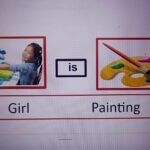- Introduction
Storytelling is a powerful tool for language development in children. One classic tale that captivates young minds is “The Lion and the Mouse.” In this article, we’ll show you how to use this story to enhance your child’s vocabulary and comprehension skills. We’ll also share a demo video of storytelling with a child, a list of vocabulary, phrases, and sentences, and provide you with a step-by-step guide on how to tell the story effectively.
Children with Autism Spectrum Disorder (ASD) often face challenges in communication, particularly in producing language with syntax. This limitation affects their overall language production abilities, impacting both their social interactions and the continuity of their learning. This article explores the ideas of vocabulary and language development of autistic children by examining how storytelling stimuli influence their abilities of learning words, phrases and sentences. After learning the given vocabulary in receptive and expressive language, it is required to generalize them in daily situations to make them understand the use of the target words.
Demo Video
[Watch the demo video of “The Lion and the Mouse” storytelling online session with a child.]
Vocabulary list from the storytelling
Here is the list of words, phrases, and sentences used in the story:
Words :
Sleeping, Under, Mouse, Sliding, Jumping, On, Tail, Back, Woke, Angry, Roar, Grabbed, Scared, Sorry, Thank, Walking, Stuck, Closed, Net, Climbing, Cut, Came, Happy, Friends
Phrases :
Under a tree, Mouse came, On lion’s back, On his tail, Lion woke up, Woke up, Lion is angry, Lion is roaring loudly, Grabbed the mouse, Mouse was very scared, Let me go, Thank you, Walking, Lion is walking, Stuck in the net, Closed in the net, Climbing on the net, Cut the net, Lion came out, Lion is happy, Good friends
Sentences :
The lion is sleeping, and the mouse is sliding. Suddenly, the lion woke up and became angry. He grabbed the mouse, and the mouse was very scared. “Please don’t eat me,” the mouse said. “I am very scared. Let me go, and I will help you.
” The lion started walking and he found himself caught in a net. The mouse began climbing on the net, helping the lion to escape. The lion came out and he was happy. They both became good friends.
Lion and the mouse– link of the story
Steps of Storytelling
Show the Story Video or Read the Story:
Depending on your child’s interest, either show the full video or read the given link of the story “The Lion and the Mouse.”
Based on your child’s preference, you can choose to either play the full video or read the linked story, “The Lion and the Mouse.” This approach allows you to cater to their interest in visual or auditory learning.
Pause, Play, and Tell the Story:
While watching the video or reading the story, take breaks at key moments to explain and emphasize the story elements. Use these pauses to engage your child by asking questions about what happened and encouraging them to predict what might come next.
You can refer to the demo video for guidance on where to pause and how to discuss the events. Make sure to speak all the words, phrases, and sentences clearly, and tell the story at a pace that suits your child’s understanding, allowing them to absorb and understand the vocabulary.
Repeat this process a few times to reinforce learning.
Use Puppets, Toys, or Props:
To make the story time more interactive and enjoyable, use puppets, toys, or props to represent the lion and the mouse. Act out the story with these tools, encouraging your child to participate and engage with the narrative. This hands-on approach will help make the storytelling experience more memorable.
Reinforce Vocabulary:After your child becomes familiar with the new vocabulary, it’s important to reinforce it by using the words in various situations over the next few days. For instance, if the word is “angry,” try to incorporate it into daily conversations whenever someone expresses anger. This repetition will help solidify their understanding and usage of the new vocabulary.
Once your child learns the vocabulary, it is important to use it in ten different situations regularly over a few days. For example, if the word is “angry,” try to incorporate it whenever someone feels ‘angry’ during daily life
Conclusion
By using “The Lion and the Mouse” for storytelling, you can create a language rich and engaging environment for your child’s language development. In addition, remember to be patient and consistent. As a result, you’ll soon see significant improvements in their vocabulary and comprehension skills. Happy storytelling!
Check this story idea also to begin with the story telling- Beginners story telling- Cookies
If your child hasn’t started speaking till now- go through our KIds talk program
- Check and calculate your child’s language age
- How speech and language therapy work
- How to use play to teach communication skills
- Single words to meaningful language
- Two words phrases
- Learn to speak in sentences- coming soon
Click to buy important resources, These are created by Spectraspeech.
- Verbs/ action words in pictures
- Two words Phrases
- Verbs in Sentences
These products are the legally copyrighted. Please do not distribute from your end or make copies. Allowed to use for your child, if you are a parent.
Instead share the link- https://speechtherapys.com/2024/07/22/storytelling-ideas-the-lion-and-the-mouse/



